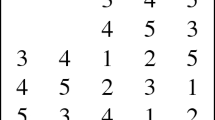Abstract
A method to compare two-associate-class PBIB designs is discussed. As an application, it is shown that ifd * is a group-divisible design withλ 2=λ1+1, a group divisible design with group size two andλ 2=λ1+1>1, a design based on a triangular scheme andv=10 andλ 1=λ2+1, a design with anL 2 scheme andλ 2=λ1+1, a design with anL s scheme,v=(s+1) 2, andλ 2=λ1+1, wheres is a positive integer, or a design with a cyclic schemev=5, andλ 1=λ2±1, thend * is optimum with respect to a very general class of criteria over all the two-associate-class PBIB designs with the same values ofv, b andk asd *. The best two-associate-class PBIB design, however, is not necessarily optimal over all designs.
Similar content being viewed by others
References
Bose, R. C. and Nair, K. R. (1939). Partially balanced incomplete block design,Sankhyā,4, 337–372.
Cheng, C. S. (1978). Optimality of certain asymmetrical experimental designs,Ann. Statist.,6, 1239–1261.
Cheng, C. S. (1980). On theE-optimality of some block designs,J. R. Statist. Soc., B,42, 199–204.
Clatworthy, W. H. (1973).Tables of Two-Associate-Class Partially Balanced Designs, Nat. Bur. Stand. (U.S.), Appl. Math. Ser.63.
Connor, W. S. and Clatworthy, W. H. (1954). Some theorems for partially balanced designs,Ann. Math. Statist.,25, 100–112.
Kiefer, J. (1958). On the nonrandomized optimality and randomized nonoptimality of symmetrical designs,Ann. Math. Statist.,29, 675–699.
Kiefer, J. (1975). Construction and optimality of generalized Youden designs, inA Survey of Statistical Designs and Linear Models (ed. J. N. Srivastava), North-Holland, Amsterdam, 333–353.
Mesner, D. M. (1965). A note on the parameters of PBIB association schemes,Ann. Math. Statist.,36, 331–336.
Mirsky, L. (1963). Results and problems in the theory of doubly stochastic matrices,Zeit. Wahrscheinlichkeitsth.,1, 319–334.
Mitchell, T. J. and John, J. A. (1976). Optimal incomplete block designs, ORNL/CSD-8, Oak Ridge National Laboratory Report.
Raghavarao, D. (1971).Constructions and Combinatorial Problems in Design of Experiments, Wiley, New York.
Takeuchi, K. (1961). On the optimality of certain type of PBIB designs,Rep. Statist. Appl. Res. Un. Japan Sci. Engrs.,8, 140–145.
Author information
Authors and Affiliations
Additional information
This paper was prepared with the support of Office of Naval Research Contract No. N00014-75-C-0444/NR 042-036 and National Science Foundation Grant No. MCS-79-09502.
About this article
Cite this article
Cheng, CS. On the comparison of PBIB designs with two associate classes. Ann Inst Stat Math 33, 155–164 (1981). https://doi.org/10.1007/BF02480929
Received:
Revised:
Published:
Issue Date:
DOI: https://doi.org/10.1007/BF02480929




